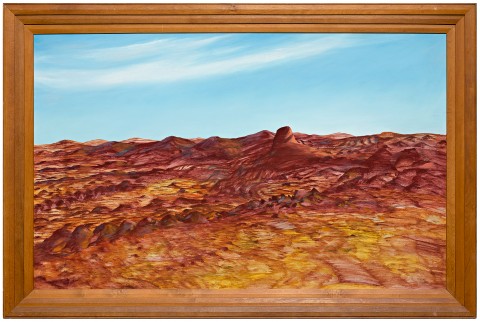HARTZ RANGE, 1950
SIDNEY NOLAN
oil and enamel paint on composition board
78.0 x 121.5 cm
signed and dated lower right: 11- 1- 50 / Nolan
David Jones' Art Gallery, Sydney
Mr R.A.G. Henderson, Sydney
Lawsons, Sydney, 16 July 1991, lot 310
Gould collection, Melbourne
Sidney Nolan: Exhibition of Central Australian Landscapes, David Jones' Art Gallery, Sydney, 31 March – 14 April 1950, cat. 5
Australian Art, Gould Galleries, Hong Kong, 22 November – 1 December 1991, cat. 11
Sidney Nolan: Desert and Drought, National Gallery of Victoria, Melbourne, 6 June – 17 August 2003, cat. 23
Smith, G., Sidney Nolan: Desert and Drought, National Gallery of Victoria, Melbourne, 2003, p. 45 (illus.)
Following his first experience of flying in 1947 Sidney Nolan wrote excitedly, ‘it seems to me one of the best possible means for seeing and understanding the landscape! Only one aspect it is true but what an aspect.’1 Two years later he visited Central Australia with his new wife Cynthia and her daughter Jinx, travelling extensively for two and a half months and viewing the desert landscape from the air. Three days after their arrival in Alice Springs, Nolan recorded in his diary:
‘Today went on a mail flight for four hundred miles over the Hartz Range & to the eastern extremity of the MacDonnell Ranges… In the morning the light on the hills was like gauze as Cynthia so accurately described it. Transparent & at the same time impenetrable.’2
Returning to the studio Nolan struggled to capture the essence of the ancient landscape but by the start of October, he had completed the first picture in the series that would in effect launch his international career.
An exhibition of forty-seven Central Australian landscapes opened at David Jones’ Gallery, Sydney at the end of March 1950. It was a commercial and popular success with nine paintings selling at the opening, including Dry Jungle, 1949 to the National Art Gallery of New South Wales, Sydney and Hartz Range, 1950 purchased by Rupert Henderson, Managing Director of John Fairfax Limited. By the end of the exhibition a total of seventeen paintings had been sold.3 The National Gallery of Victoria, Melbourne purchased Central Australia, 1949 before the exhibition and in a remarkable vote of confidence, bought another painting from the series when it was shown in Melbourne later that year. By applying layers of oil paint and enamel and then burnishing them back, Nolan was able to capture the luminosity of the desert and there is a delicacy in these paintings that belies the monumental nature of their subject. In Hartz Range, the striated surface of the landscape appears like a vast skin pulled taut in the foreground that ripples and wrinkles as the mountains rise out of the ground and recede into the distance.
The success of these pictures continued when Inland Australia, 1950 won first prize in the inaugural Dunlop Australian Art Contest. The series also achieved significant international recognition with a painting being purchased by the Tate, London in 1951 and another by the esteemed British art historian, Sir Kenneth Clark.
James Gleeson recognised the significance of this celebrated series of paintings in a review that described the exhibition as ‘one of the most important events in the history of Australian painting… future art historians will date the birth of a predominantly Australian idiom from this exhibition… Nolan has been able to bring the vision of the poet and a respect for the objective facts of Nature into a single focus.’4
1. Sidney Nolan, letter to Albert Tucker, Brisbane, 16 July 1947, in Albert Tucker Papers, La Trobe Collection, State Library of Victoria, Melbourne, cited in Smith, G., Sidney Nolan: Desert and Drought, National Gallery of Victoria, Melbourne, 2003, p. 12
2. Sidney Nolan, diary notes, Alice Springs, 28 June 1949, Jinx Nolan Papers, cited in Smith, ibid., p. 16
3. See Smith, ibid., p. 25
4. Gleeson, J., ‘Landscapes triumph for Aust. Artist’, Sun, Sydney, 31 March 1950, p. 19
KIRSTY GRANT


